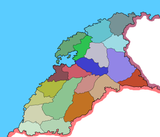Search Results
ID: Ty1hV/Wk/qst/6271040#6276966
7/19/2025, 12:34:36 PM
ID: PBhKDqrt/qst/6259847#6276963
7/19/2025, 12:24:47 PM
If there was one thing Greifswald lacked in terms of administration, it was subdivisions. Until recently, the kingdom had been a duchy and was thus small enough to oversee the various feudal fiefdoms that were scattered in between the then ducal domains.
The old castelancies, or Burgvogteien , dating back all the way to the times of the County of Grünwald, were too small, the various feudal fiefs were too many, and the royal demesne was too large.
In Mithras, the Empire had been divided into several Themes, which were responsible for the local administration. It could be a good example of how to build your new model; within Angenland, the land was subdivided into several shires. With an attached shire reeve, or sheriff and constable. In Tautenland, the land still was divided along the lines of the old Stammesherzogtumen that once constituted the five great Tauten tribes. In Aurilie, the kings had been experimenting with the use of provinces for a while now. Even further back still, during the early times of the Lothringian Empire, the realm was divided into several Gaue, or counties.
The order, of course, had divided the land as well along entities known as Vogteien or Baliwicks with a vogt at the head. And into commanderies known as Komtureien which were governed by a commander appointed by the order's master.
There was a lot to gain in terms of administrative improvements; the court system was slowly being clamped down with claims of overlapping jurisdictions, resulting in confusion and inefficiency. Similar problems were had with the collection of taxes and the levying of troops. Setting and clarifying boundaries thus became your new objective.
With the weather worsening as the year nearly drew to a close, you found yourself drawing along with a set of maps while simultaneously having hired some men to place boundary markers along the new borders, which you had drawn up in such a way that they roughly corresponded to the natural borders like rivers, mountains, and the forests, as well as the fiefs of the lords. By the time you were done with making the initial draft, you had created nineteen new subdivisions, though to round it off more neatly, you made it into twenty subdivisions. Each one of them had at least one town of note within them, where the local courts of justice had already been established. They were, of course, not made equal; the largest of them were usually also the ones that were the most sparsely populated.
Anastasia had at one point mentioned something about a period of Mithradian history where the tasks of the military and civilian administration had been divided among the two, to make it more clear what one's task was and to make it harder for them to rebel.
The old castelancies, or Burgvogteien , dating back all the way to the times of the County of Grünwald, were too small, the various feudal fiefs were too many, and the royal demesne was too large.
In Mithras, the Empire had been divided into several Themes, which were responsible for the local administration. It could be a good example of how to build your new model; within Angenland, the land was subdivided into several shires. With an attached shire reeve, or sheriff and constable. In Tautenland, the land still was divided along the lines of the old Stammesherzogtumen that once constituted the five great Tauten tribes. In Aurilie, the kings had been experimenting with the use of provinces for a while now. Even further back still, during the early times of the Lothringian Empire, the realm was divided into several Gaue, or counties.
The order, of course, had divided the land as well along entities known as Vogteien or Baliwicks with a vogt at the head. And into commanderies known as Komtureien which were governed by a commander appointed by the order's master.
There was a lot to gain in terms of administrative improvements; the court system was slowly being clamped down with claims of overlapping jurisdictions, resulting in confusion and inefficiency. Similar problems were had with the collection of taxes and the levying of troops. Setting and clarifying boundaries thus became your new objective.
With the weather worsening as the year nearly drew to a close, you found yourself drawing along with a set of maps while simultaneously having hired some men to place boundary markers along the new borders, which you had drawn up in such a way that they roughly corresponded to the natural borders like rivers, mountains, and the forests, as well as the fiefs of the lords. By the time you were done with making the initial draft, you had created nineteen new subdivisions, though to round it off more neatly, you made it into twenty subdivisions. Each one of them had at least one town of note within them, where the local courts of justice had already been established. They were, of course, not made equal; the largest of them were usually also the ones that were the most sparsely populated.
Anastasia had at one point mentioned something about a period of Mithradian history where the tasks of the military and civilian administration had been divided among the two, to make it more clear what one's task was and to make it harder for them to rebel.
Page 1
